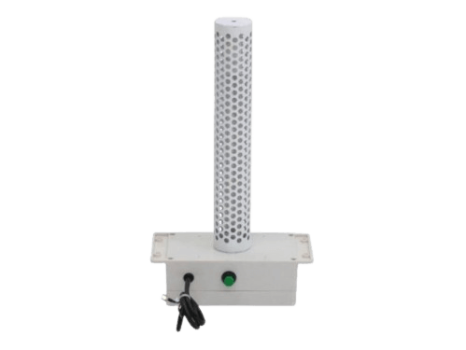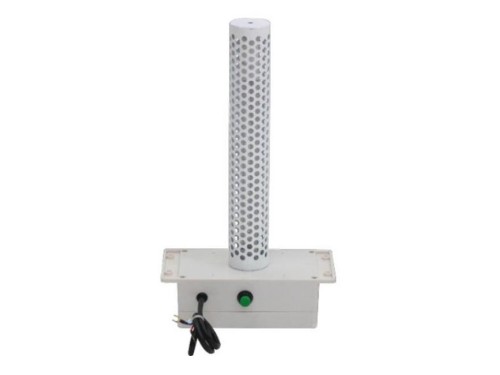HVAC UV Light System

HVAC UV light systems are air purification systems that use ultraviolet (UV) light to clean the air in heating, ventilation, and air conditioning (HVAC) systems. The UV lights are installed in the ductwork or on the coil of the HVAC system, and as the air flows through, the UV light kills or inactivates microorganisms, such as mold, bacteria, and viruses, that may be present in the air. This can improve the overall air quality in the building, reduce the spread of harmful pathogens, and prevent the growth of mold and bacteria in the HVAC system.
-
HVAC UV Light System
Plug-in Type HVAC UV Light (20W)
-
HVAC UV Light System
Plug-in Type HVAC UV Light (8W)
-
HVAC UV Light System
Plug-in Type HVAC UV Light (5W)
Features
HVAC UV light systems typically have several key features, which may include:
UV-C light emitters: The core component of an HVAC UV light system is the UV-C light emitters, which emit ultraviolet light at a wavelength that is effective at killing or inactivating pathogens.
Easy installation: HVAC UV light systems are designed to be easy to install and can be integrated into existing HVAC systems.
Compact design: The HVAC UV light systems are designed to be small, efficient and easy to install in tight spaces.
Durable construction: HVAC UV light systems are built to withstand the harsh environment of an HVAC system, including exposure to heat, dust, and vibration.
Remote monitoring: Some systems come with remote monitoring capabilities which allow you to monitor the system’s function remotely.
UV intensity monitoring: Systems can have sensors to monitor UV light intensity, which helps to ensure that the UV light is operating at the correct level.
Safety shut offs: Some systems include automatic shut offs in case of malfunction or if someone is present in the room.
Lamp replacement indicator: This alerts you when the UV-C lamp needs to be replaced.
Keep in mind that not all systems have all of the features listed above and some can include additional features. The features of an HVAC UV light system will vary depending on the specific product or manufacturer.
How does the HVAC UV light system work?
How to install UV light system to your HVAC?
How to Choose UV Light System for HVAC?
When choosing an HVAC UV light system, there are several factors to consider, such as:
Size and type of your HVAC system: Choose a system that is compatible with your HVAC system size and type.
Room Size and usage: Consider the room size, usage, and the airflow of the area you will be installing the UV light system. This will help you decide on the number of lamps, and lamp wattage you will need for your system.
Type of UV-C light: UV-C light systems comes in different types, such as low-pressure mercury vapor, medium-pressure mercury vapor, or high-intensity UV-C LEDs. It’s important to understand the differences between these types of UV-C light emitters to choose one that will be most effective for your needs.
Wattage and lamp life: Consider the power and lamp life of the UV-C light emitters when choosing a system. Some lamps have a longer life than others, and some are more powerful.
Remote monitoring and control: Some systems come with remote monitoring and control options that allow you to check the system’s status and make adjustments remotely.
Safety features: Look for systems with safety features like automatic shut-offs and sensors that detect the presence of people in the room.
UV intensity monitoring: UV intensity monitoring sensors ensures that UV light is reaching the correct intensity for the area and warns you when the system requires maintenance.
cost: Compare the costs of different systems and consider the long-term benefits of investing in a higher-quality, more expensive system that may have a longer life and better performance.
It’s advisable to do some research and compare different systems from different manufacturers to find one that is a good fit for your needs and budget. It would be good to consult with experts in the field before making a final decision.
Applications
HVAC UV light systems have a variety of applications in both commercial and residential settings. Some of the most common applications include:
Air purification: HVAC UV light systems are effective at killing or inactivating a wide range of pathogens, including bacteria, viruses, and mold, which can help to improve indoor air quality and reduce the spread of illness.
HVAC system maintenance: HVAC UV light systems can be used to help maintain and disinfect HVAC systems, which can improve the efficiency and longevity of the equipment.
Allergies and asthma relief: HVAC UV light systems can help to reduce the presence of allergens and other irritants in the air, which can provide relief for people with allergies or asthma.
Odor control: HVAC UV light systems can help to neutralize odors caused by bacteria, mold, or other pollutants.
Hospital and healthcare facilities: UV light systems are often used in hospitals, clinics, and other healthcare facilities to help reduce the spread of infections by inactivating pathogens in the air.
– Commercial buildings such as office buildings, malls, and schools.
– Residential buildings and homes
It’s important to note that the effectiveness of an HVAC UV light system may vary depending on factors such as the specific type of pathogen, the intensity of the UV light, and the design of the HVAC system.
FAQs of HVAC UV Light System
Please don’t hesitate to contact us if your question doesn’t find the corresponding answer below, , we are glad to help you.
HVAC UV light systems work by emitting UV-C light, which is a specific wavelength of ultraviolet light that is effective at killing or inactivating pathogens, such as bacteria and viruses. The UV-C light is directed at the air inside the HVAC system, and as the air passes through, the pathogens are neutralized or killed.
HVAC UV light systems can improve indoor air quality, reduce the spread of illness, and lower the risk of respiratory infections. They can also help to maintain and disinfect HVAC systems, and reduce the presence of allergens and odors.
The lamp life of an HVAC UV light system can vary depending on the specific product and manufacturer, but most lamps need to be replaced every 9-12 months. Some systems include a lamp replacement indicator to alert you when it's time to replace the lamp.
An HVAC UV light system will not remove all pathogens from the air, but it can significantly reduce their presence. It is important to note that UV-C light systems will not remove all particles or gaseous pollutants, which is why combining multiple air purification technologies is often recommended.
The amount of time it takes for UV-C light to kill pathogens can depend on several factors, such as the intensity of the UV light, the type of pathogen, and the distance from the UV-C light emitters. In general, most pathogens are killed or inactivated within a matter of seconds or minutes.
Most HVAC UV light systems are safe for people to be in the room when they are in operation. Some systems include safety features such as automatic shut-offs if someone is present in the room. It's always important to read and follow the manufacturer's instructions and safety precautions to ensure the safe usage of the system.
Contact us to get our latest brochure & pricelist for HVAC UV light system
Are you an HVAC contractor/installer? Would you like to be our distributor? Contact us to make your business more profitable.

